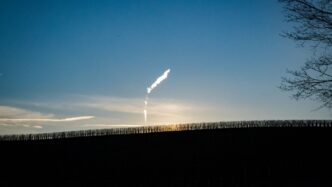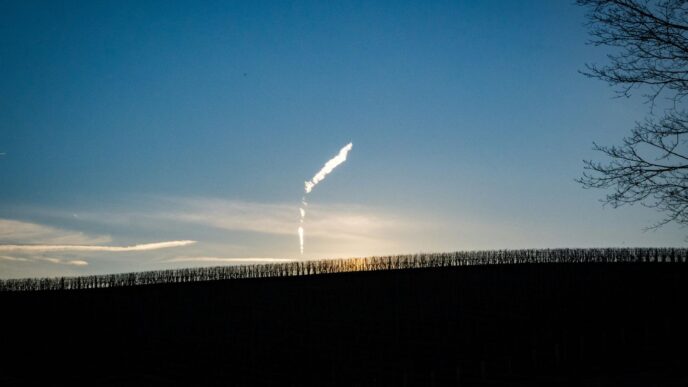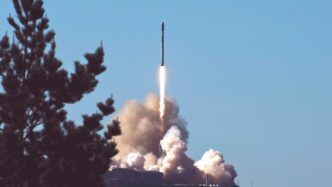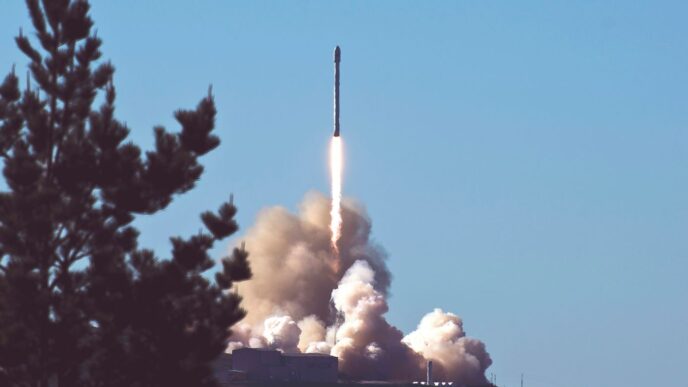Blue Origin’s New Glenn rocket is a big deal in the space world. Everyone’s watching to see how they handle the booster landings, especially after the first try didn’t quite stick. This whole reusability thing is a game-changer for space travel, making it cheaper and more common. We’ll look at what happened, what’s next, and why successful New Glenn booster landing is so important for the future.
Key Takeaways
- The first New Glenn booster landing attempt, with the booster named “So You’re Telling Me There’s a Chance,” didn’t work out as planned, but it gave Blue Origin important information.
- Blue Origin is aiming to make the New Glenn booster reusable, like SpaceX’s Falcon 9, to cut down on launch costs and open up new possibilities.
- The next New Glenn booster landing attempt will feature a booster called “Never Tell Me The Odds,” showing Blue Origin’s continued effort.
- Improvements in engine design and booster manufacturing are key to making future New Glenn booster landing attempts successful.
- A successful New Glenn booster landing is important for Blue Origin to compete in the space launch market and support future missions, including those to the Moon.
The Inaugural New Glenn Booster Landing Attempt
The first launch of the New Glenn rocket was a big deal, no doubt. It happened on January 16, 2025, at 2:03 AM EST. Blue Origin managed to get the rocket into orbit, which is a huge accomplishment for a first try. The GS-2 upper stage and the Blue Ring prototype payload made it to medium earth orbit. However, the plan was always to try and land the first stage booster, called GS-1, on a ship after it separated. That’s where things got a little complicated.
Naming the First New Glenn Booster
So, the first New Glenn booster had a pretty memorable name: "So You’re Telling Me There’s a Chance." It’s kind of funny, right? Apparently, Blue Origin has a tradition of giving their hardware cool names, going all the way back to New Shepard. The name was chosen because, well, nobody had ever successfully landed a reusable booster on the very first try. It was ambitious, to say the least, and showed a good sense of humor about the whole thing. It’s a bold move in the air transportation market to attempt such a feat on the first launch.
Challenges of the Initial New Glenn Booster Landing
Landing a booster isn’t easy. The New Glenn booster was traveling at something like Mach 5.5 at an altitude of 84,226 feet when it was lost. That’s seriously fast. The plan was to bring it down on the ship Jacklyn, which was stationed in the Atlantic Ocean, a few hundred kilometers away from Cape Canaveral. But, during reentry, the telemetry and video feed cut out around the T+7:55 mark. Blue Origin later confirmed that the booster was lost. It’s a tough challenge, trying to control something moving that fast through the atmosphere.
Lessons Learned from the First New Glenn Booster Landing
Even though the landing didn’t work out, the whole mission wasn’t a failure. Blue Origin did get to orbit, which is a major win. Dave Limp, the CEO, said they knew landing the booster on the first try was a long shot. The important thing is that they learned a lot from the attempt. After the failed landing, the FAA got involved and required Blue Origin to conduct a mishap investigation. The company submitted its initial findings pretty quickly and aimed to launch New Glenn again in the spring. Every launch provides data that helps refine future attempts.
Blue Origin’s Reusability Vision for New Glenn Booster Landing
Achieving Cost Reduction Through New Glenn Booster Landing
Blue Origin’s core vision for the New Glenn rocket hinges on reusability. The idea is simple: by recovering and reusing the first stage booster, they can drastically cut down on launch costs. This approach aims to make space access more affordable and frequent. Think of it like flying a plane multiple times versus building a new one for each flight. Reusability is the key to unlocking more opportunities in space, from scientific missions to commercial ventures. It’s not just about saving money; it’s about making space accessible to more people and organizations.
Comparing New Glenn Booster Landing to SpaceX Falcon 9
SpaceX has already proven that reusable rockets are not just a pipe dream. Their Falcon 9 boosters land regularly, a feat that has revolutionized the industry. Blue Origin is following a similar path, aiming to recover the New Glenn booster on a landing platform vessel. The big difference? SpaceX has a significant head start. Blue Origin needs to demonstrate that their approach is reliable and cost-effective. If they can achieve similar levels of reusability, it would position them as a major competitor in the orbital payload market. It’s a race to see who can make space travel the most efficient and affordable.
The Role of Jacklyn in New Glenn Booster Landing
Just like SpaceX uses drone ships for landing Falcon 9 boosters, Blue Origin has its own vessel: Jacklyn. Named after Jeff Bezos’ mother, Jacklyn is a crucial part of the New Glenn recovery process. The booster is designed to land vertically on this ship after completing its initial ascent. Getting the New Glenn rocket to land safely on Jacklyn requires precision and a bit of luck. It’s a complex operation involving advanced navigation and control systems. If successful, it will be a major step towards realizing Blue Origin’s reusability vision.
Upcoming New Glenn Booster Landing Missions
The Second New Glenn Booster Landing Attempt
After the initial New Glenn launch in January, all eyes are on the second attempt. The first launch aimed high, trying to land the booster on the Jacklyn recovery vessel, but it didn’t quite work out. The second launch is scheduled for August 15th, and the team is determined to achieve a successful booster landing this time around. It’s not just about getting the rocket into space; it’s about proving that reusable boosters are a viable option for the future. The success of this mission is important for Blue Origin to establish itself as a major player in the orbital payload market.
Naming the Second New Glenn Booster
Following the tradition of giving Blue Origin hardware cool names, the second New Glenn booster has been christened "Never Tell Me The Odds." This name reflects the team’s determination and a bit of humor, acknowledging the challenges of landing a reusable booster. The first booster was named "So You’re Telling Me There’s a Chance," which shows the company’s spirit. It’s a fun way to build excitement and show that even rocket scientists have a sense of humor. These names add a bit of personality to the New Glenn rocket program.
Key Objectives for Future New Glenn Booster Landing
The primary goal for future New Glenn missions is, of course, to consistently and reliably land the booster. This involves several key objectives:
- Improving landing accuracy: Fine-tuning the guidance systems to ensure the booster lands precisely on the Jacklyn.
- Enhancing engine performance: Making sure the engines can handle the stress of landing and reuse.
- Increasing reusability: Designing the booster to withstand multiple launches and landings without significant refurbishment.
Achieving these objectives will not only reduce launch costs but also pave the way for more frequent and ambitious space missions. The ability to reuse boosters is a game-changer, and Blue Origin is working hard to make it a reality.
Technological Advancements for New Glenn Booster Landing
Refining Engine Performance for New Glenn Booster Landing
Engine performance is, like, super important for getting that New Glenn booster to stick its landing. It’s not just about raw power; it’s about precision and control during the descent. We’re talking about fine-tuning the BE-4 engines to handle the atmospheric reentry and the final landing burn. It’s a tricky balance, and Blue Origin is working on some cool stuff to make it happen. They’re looking at things like:
- Improving the thrust vector control (TVC) system for better maneuverability.
- Optimizing the engine cycle for greater efficiency during the landing phase.
- Implementing advanced diagnostics to monitor engine health in real-time.
Improvements in New Glenn Booster Design
It’s not just the engines, though. The whole booster design is getting a makeover. The goal is to make it more robust and reliable for repeated landings. Think about it – this thing has to withstand extreme temperatures, pressures, and forces. So, Blue Origin is tweaking the design in a few key areas:
- Strengthening the heat shield to protect against reentry heat.
- Improving the aerodynamic stability of the booster during descent.
- Adding more sensors and data collection systems to monitor performance.
The Evolution of Landing Platforms for New Glenn Booster Landing
Okay, so the original plan was to use a hydrodynamically stabilized ship called Jacklyn as a landing platform. But, plans change, right? That ship got scrapped, and now they’ve got a new landing barge, also nicknamed Jacklyn, called Landing Platform Vessel 1. It became operational in 2024. The landing platform is a big deal because it needs to be stable enough to handle the booster coming down, even in rough seas. Here’s what they’re working on:
- Improving the platform’s stability and maneuverability.
- Developing advanced guidance systems to help the booster land precisely on the platform.
- Adding safety features to protect the platform and the surrounding environment.
Strategic Importance of New Glenn Booster Landing
New Glenn Booster Landing in the Orbital Payload Market
Getting New Glenn fully operational is a big deal because it throws Blue Origin into the orbital payload market, which is currently dominated by SpaceX. If Blue Origin can nail reusability with the rocket’s booster, it could seriously bring down launch costs. This would make space more accessible for everyone.
Supporting NASA Missions with New Glenn Booster Landing
New Glenn is set to play a key role in supporting NASA missions, especially those related to lunar exploration. The rocket is designed to carry heavy payloads, making it ideal for transporting equipment and supplies to the Moon. Future New Glenn missions will carry the Blue Moon Mark 1 cargo lander and the Mark 2 crewed lander to the Moon as part of NASA’s Artemis program. This support is vital for establishing a sustained human presence on the Moon. The low-level design is critical for mission success.
New Glenn Booster Landing for Commercial Satellites
Beyond government contracts, New Glenn is also targeting the commercial satellite market. The ability to reuse the booster means more frequent and cheaper launches, which is attractive to companies looking to deploy or maintain satellite constellations. This could open up new opportunities for communication, Earth observation, and other space-based services.
Here’s a quick look at the potential impact:
- Increased launch frequency
- Reduced costs for satellite deployment
- Greater access to space for commercial ventures
Overcoming Engineering Hurdles for New Glenn Booster Landing
Addressing Engine Performance Issues for New Glenn Booster Landing
One of the biggest challenges for New Glenn is getting the engines to perform exactly as expected, every single time. The BE-4 engines, which power the first stage, have undergone extensive testing, but real-world flight conditions introduce new variables. Minor variations in fuel mixture, combustion stability, and nozzle performance can significantly impact the booster’s trajectory and landing accuracy. Blue Origin engineers are constantly analyzing data from test flights and simulations to refine engine control algorithms and improve overall reliability. It’s a process of continuous improvement, tweaking parameters and making adjustments to ensure consistent performance.
The Production of Subsequent New Glenn Boosters
Building one rocket is hard; building many is a different kind of hard. Scaling up production of the New Glenn boosters presents its own set of engineering and logistical challenges. It’s not just about replicating the design; it’s about establishing efficient manufacturing processes, managing supply chains, and ensuring quality control at every stage. Here are some key considerations:
- Material Sourcing: Securing a reliable supply of high-quality materials, like specialized alloys and composite materials, is crucial.
- Manufacturing Precision: Maintaining tight tolerances and consistent quality across multiple boosters requires advanced manufacturing techniques and rigorous inspection processes.
- Skilled Workforce: Training and retaining a skilled workforce capable of assembling and testing complex rocket components is essential.
Ensuring Successful Takeoff and New Glenn Booster Landing
Getting New Glenn off the ground is only half the battle; bringing the booster back for a controlled landing is where things get really tricky. The landing sequence involves a series of complex maneuvers, including reentry burns, aerodynamic control, and precise engine throttling. The ultimate goal is to stick the landing on the Jacklyn landing platform in the Atlantic Ocean. Here’s a breakdown of the key challenges:
- Atmospheric Reentry: Surviving the intense heat and pressure of atmospheric reentry requires robust thermal protection systems and precise control of the booster’s orientation.
- Guidance and Control: Accurately guiding the booster to the landing site requires sophisticated navigation systems and responsive control surfaces.
- Engine Restart and Throttling: Reliably restarting the engines and precisely controlling their thrust is critical for a soft landing. The BE-4 engine needs to perform flawlessly during this phase.
It’s a high-stakes game, and every flight provides valuable data for improving the odds of success. The FAA requires a mishap investigation for any failed landing, ensuring that lessons are learned and incorporated into future designs and procedures. Blue Origin is aiming to expand lunar missions with New Glenn, so they need to get this right.
The Future Trajectory of New Glenn Booster Landing

Expanding Capabilities with New Glenn Booster Landing
The successful landing and reuse of the New Glenn booster opens up a world of possibilities. It’s not just about saving money; it’s about enabling more frequent and ambitious space missions. Think about it: quicker turnaround times mean more launches per year. This increased launch cadence can revolutionize everything from satellite deployment to space tourism. Plus, the ability to recover and refurbish boosters allows for continuous improvement and refinement of the technology. The aerospace parts manufacturing market’s innovations will be crucial in this aspect.
New Glenn Booster Landing for Lunar Missions
Blue Origin has big plans for the Moon, and New Glenn is central to those ambitions. The rocket is designed to carry the Blue Moon lander, both cargo and crewed versions, as part of NASA’s Artemis program. Landing the booster reliably is key to making these lunar missions sustainable and affordable. Imagine a future where regular trips to the Moon are commonplace, supporting scientific research, resource extraction, and even the establishment of a permanent lunar base. New Glenn’s reusability is a game-changer in making that vision a reality. The initial New Glenn booster landing attempt was a learning experience.
Sustained Human Presence Enabled by New Glenn Booster Landing
Ultimately, the goal is to create a future where humans have a continuous presence in space. New Glenn’s reusability is a critical step towards achieving that goal. By lowering the cost of access to space, it becomes more feasible to build and maintain space stations, conduct long-duration research, and even explore beyond the Moon. A sustained human presence in space could lead to:
- New scientific discoveries
- The development of new technologies
- The expansion of human civilization beyond Earth
It’s an ambitious vision, but with reusable rockets like New Glenn, it’s starting to feel within reach. The low-level design of New Glenn is constantly being improved.
What’s Next for New Glenn Booster Landing?
So, what does all this mean for New Glenn? Well, it’s pretty clear that getting that booster back is a big deal for Blue Origin. They’ve had some ups and downs, like that first try where the booster didn’t make it back to the ship. But they’re not giving up, which is cool. They’re learning from what happened, making changes, and getting ready for the next launch. It’s a tough job, and it takes a lot of work to get these huge rockets to land safely. If they can pull it off consistently, it’ll change things a lot for space travel, making it cheaper and maybe even more common. We’ll just have to wait and see how it all plays out, but it’s definitely going to be interesting to watch.
Frequently Asked Questions
What was the name of the first New Glenn booster?
The very first New Glenn booster was given the fun name “So You’re Telling Me There’s a Chance.” This name showed how tricky it is to land a rocket booster on its first try, something no one had done before.
What happened during the first New Glenn booster landing attempt?
The first try to land the New Glenn booster didn’t go as planned. Even though the top part of the rocket made it to space, the booster itself didn’t land safely on the ship called Jacklyn. This meant Blue Origin had to learn from what went wrong.
How does reusing the New Glenn booster help Blue Origin?
Blue Origin wants to make space travel cheaper by reusing their rockets. By landing the boosters, they don’t have to build a new one every time. This is like how SpaceX reuses its Falcon 9 rockets, which has really helped them save money.
What is the role of Jacklyn in New Glenn booster landings?
The Jacklyn is a special ship that Blue Origin uses to try and catch the New Glenn booster when it comes back down from space. It’s named after Jeff Bezos’s mom and is super important for their plan to reuse rockets.
What is the name of the second New Glenn booster?
The second New Glenn booster is called “Never Tell Me The Odds.” This name also hints at the big challenge of landing these rockets, but it shows Blue Origin’s determination to succeed.
What are the main goals for upcoming New Glenn booster landings?
For future New Glenn missions, the main goals are to successfully launch the rocket and then safely land the booster back on Earth. Blue Origin is working hard to fix any issues from the first try to make sure the next landings are successful.














